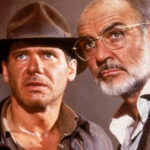

Since its release in 1975, “Jaws” has established itself as a cinema classic, triggering both fascination and terror in audiences with its relentless portrayal of one of the most feared predators of the oceans. Behind the scenes of suspense and tension, there’s a fascinating array of trivia surrounding the production of this iconic Steven Spielberg film. From the challenges faced during filming to the lasting cultural impacts the movie has had, delving into these curiosities offers us a unique perspective on the making of one of the most influential films in cinema history.
1 – FILMING AT SEA
The production of the film began in May 1974 and faced numerous challenges, becoming a true ordeal without the benevolence of the weather. Spielberg, then 27 years old, received harsh criticism for choosing to shoot most of the scenes in the Atlantic Ocean, facing all the adversities and surprises that the sea can present, instead of using a lake or a tank in Hollywood. Despite all the setbacks, the director never regretted his choice.
According to him, “The water of a lake or a tank does not possess the same quality and intensity as the ocean, and this story needed to convincingly convey the terror of a giant great white shark, otherwise, no one would believe it,” as stated in the documentary “Jaws, the Inside Story,” produced on the occasion of the film’s 35th anniversary.
2 – THE SHOOTING WAS A NIGHTMARE
Describing the production challenges of the film as mere headaches would greatly minimize the situation. As the director mentions in the same documentary, “Jaws” was both the best and worst experience of his life. In addition to dealing with the crew’s seasickness in open waters and waiting for sailboats to clear the horizon while battling currents, the production faced the massive problem of a mechanical shark, specially built for the story, that was constantly breaking down.
There were days when only a few seconds of footage were salvaged, leading the crew to nickname the film “Flaws” instead of “Jaws,” and Spielberg to dub the technical team as the “special defects department.”
3 – DELAYS HELPED MAKE THE FILM EPIC
The initial plans were completely discarded, and the initial budget of around four million dollars, along with the shooting schedule of 55 days, was drastically surpassed, tripling in size. Ironically, this turned out to be a blessing in disguise. Due to the delays, not only could the script be refined, but Spielberg was compelled to use more scenes suggesting the presence of the shark without showing it, thus intensifying the suspense of the film.
As noted in the book dedicated to the director in Cahiers du Cinéma’s Great Filmmakers Collection, this is the essence of the film: “Jaws is an example of precision and effectiveness, a provocative play with the universal phobias associated with danger lurking beneath the waters.” The director himself commented in several interviews: “The fact that the shark didn’t work turned ‘Jaws’ from a typical Saturday afternoon Japanese horror movie into a Hitchcockian thriller. What we don’t see is what really scares us.”
4 – SPIELBERG WASN’T PRESENT ON THE FINAL DAY OF SHOOTING
Before seeing the final product, director Steven Spielberg was so apprehensive about the possibility of his crew being dissatisfied after months stuck on an island that he chose not to be present for the filming of the last scene. When questioned about his absence, Spielberg confessed he feared being literally thrown into the sea as soon as the director of photography shouted “cut” for the last time. Though the reasons weren’t the most commendable, this situation ended up giving rise to a tradition: in many of his subsequent films, Spielberg opted to be absent from the final scene.
5 – EVERYONE FORBIDDEN TO WEAR RED CLOTHING
The island in question was Martha’s Vineyard, an enclave off Massachusetts that, until the summer of 1975, was known as an idyllic retreat frequented by the Kennedy family during leisure moments. Spielberg transformed this coastal paradise into a seaside setting of terror when he chose it as the location for Amity, the fictional island in the film. Among the reasons for this choice was the depth of the sea and a sandy bottom that allowed filming up to 12 miles offshore, scene after scene, with a robotic shark resting on the bottom and no strip of land in sight.
With its seaport and picturesque wooden houses, Martha’s Vineyard was the perfect location to recreate the story’s tranquil atmosphere. However, there was one fundamental condition imposed by the director on the art department: to avoid the use of the color red both in the scenery and in the costumes, so that the resulting blood from the shark attacks would have an even greater impact.
6 – MECHANICAL SHARKS
In the plot, fear is instilled by a roughly eight-meter-long great white shark. However, in reality, it wasn’t just one, but three mechanical sharks that played the role, controlled through an intricate system of pulleys connected to a kind of vessel so filled with equipment that it was dubbed the “garage sale.” In addition to the fins and a head, there was a right half of the shark, hollow on the other side, a left half to cover that part, and a complete shark. All were developed by a special effects team under the supervision of Bob Mattey, known for his expertise in marine creatures after creating the giant squid in the film “20,000 Leagues Under the Sea.”
Although menacing to viewers, among the production crew, the predator was affectionately referred to by its first name, as if it were a pet. The chosen name was Bruce, in honor of Spielberg’s lawyer, Bruce Raimer, known as a “shark” in the courts, who continues to represent Spielberg to this day.
7 – BASED ON A TRUE STORY
Benchley conceived the thriller after coming across news about a fisherman named Frank Mundus, who caught a two-ton great white shark off the shores of Long Island in 1964. The author ended up becoming quite involved in the film’s production: he contributed as a co-screenwriter for the cinematic adaptation and also made a brief appearance as an actor, portraying the role of reporter Alan Cray.
8 – THE ICONIC LINE WAS COMPLETELY IMPROVISED
One of the most iconic lines from the film, “You’re gonna need a bigger boat,” uttered by Police Chief Brody upon seeing the shark for the first time, was actually improvised by Roy Scheider, the actor portraying the character, as it wasn’t in the script. “That line has become part of people’s vocabulary when facing an insurmountable challenge,” the actor stated in the documentary “The Making of Jaws.”
9 – THE FIRST CINEMA BLOCKBUSTER
Following its premiere on June 20, 1975, “Jaws” was a phenomenal success, so much so that it was featured on the cover of Time magazine on June 23, 1975, under the title “Super Shark.” At just 28 years old, Spielberg was hailed as the king of Hollywood and left an indelible mark, forever changing how people viewed the sea. Four decades later, the perception of the film has also evolved. As noted by Cahiers du Cinéma: “What is surprising when watching ‘Jaws’ today is that this film, which defined the concept of blockbuster, bears no resemblance to a big-budget production, but rather a very well-executed B movie.”
Despite the enormous success, Spielberg still described the film as “simple.” In an interview with Sight and Sound magazine in 1977, the director stated: “With ‘Jaws,’ my goal was to create a film that impacted the audience in two ways: first with panic, then with suspense. I never aimed for anything beyond that. (…) Sometimes, I completely sacrifice style in favor of content. For me, ‘Jaws’ has no style. It boils down to content and experience. (…) Upon revisiting it, I realized it was the most simplistic film I’ve ever seen in my life. It’s just about movement, suspense, and fear.”
10 – THE UNFORGETTABLE SOUNDTRACK
The soundtrack played a crucial role in creating the atmosphere of suspense, and John Williams was awarded an Oscar for his contribution. The composer turned the presence of the shark into a theme characterized by low and repetitive tones, taken “from the depths of the orchestra,” to “express the irrational and instinctive attack of the shark.” “This creature attacks us, and we cannot face it without destroying it, due to its relentless drive,” explained the musician in the documentary “Jaws, the Inside Story.”
In summary, the 1975 film “Jaws” is not just an iconic cinematic masterpiece that unleashed a wave of terror and suspense, but also a milestone in the history of cinema. By exploring the behind-the-scenes trivia of the production, from the challenges faced during filming to the elements that contributed to its enduring success, we can appreciate the genius of Spielberg and the entire team involved. From the bold choice to film at sea to the improvisation of memorable dialogues, “Jaws” stands as a remarkable example of how talent, creativity, and determination can overcome even the greatest obstacles. Four decades after its release, the impact and influence of this film continue to resonate, captivating audiences and inspiring generations of filmmakers. Ultimately, “Jaws” is not just a movie; it is a cultural phenomenon that has left an indelible mark on the history of cinema.








